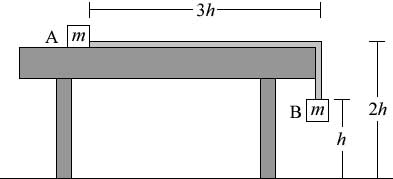Section I:
Mechanics
 |
Two small blocks, each of mass m, are connected by a string constant of lenght 4h and negligible mass. Block A is placed on a smooth tabletop as shown above, and block B hangs over teh edge of the table. The tabletop is a distance 2h about teh gloor. Block B is then released from rest at a distance h above the floor at time t = 0. Express all algebraic answers in terms of h, m, and g. |
(a) |
Determine the acceleration of block B as it descends. |
(b) | Block B strikes the floor and does not bounce. Determine the time t1 at which block B strikes the floor. |
(c) | Describe the motion of block A from time t = 0 to the time when block B strikes the floor. |
(d) | Describe the motion of block A from the time block B strikes the floor to the time block A leaves the table. |
(e) | Determine the distance between the landing points of the two blocks. |
Section II:
Electricity and Magnetism
 |
In the circuit shown above, A, B, C, and D are identical lightbulbs. Assume that the battery masintains a constant potential difference between its terminals (i.e. the internal resistance of the battery is assumed to be negligible) and the resistance of each lightbulb remains constant. |
(a) | Draw a diagram of the circuit in the box below, using the following symbols to represent the components in your diagram. Label the resistors A, B, C, and D to refer to the corresponding lightbulbs. |


(b) | List the bulbs in order of their brightness, from brightest to least bright. If any tow or more bulbs have the same brightness, state which ones. Justify your answer. |
(c) | Bulb D is then removed from its socket. |
| i. | Describe the change in brightness, if any, of bulb A when bulb D is removed from its socket. Justify your answer. |
| ii. | Describe the change in brightness, if any, of bulb B when bulb D is removed from its socket. Justify your answer. |
Section III:
Light and Optics
 |
|
(a) | Calculate the wavelength of the red line in the hydrogen spectrum. |
(b) | According to the Bohr model, the energy levels of the hydrogen atom are given by |
(c) | Qualitatively describe how the location of the first-order red line would change if a diffraction grating with 800 lines/mm were used instead of one with 600 lines/mm. |